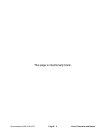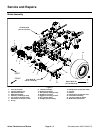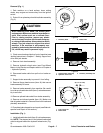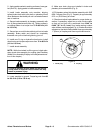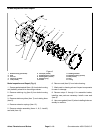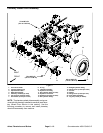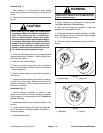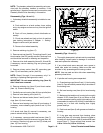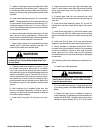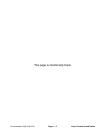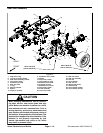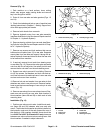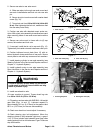
Groundsmaster 4000--D/4010--D Page 6 -- 13 Axles, Planetaries and Brakes
Removal (Fig. 7)
1. Park machine on a level surface, lower cutting
decks, stop engine and remove key from the ignition
switch.
2. Drain oil from planetary wheel drive/brake assembly
(Fig. 8).
CAUTION
When removing front wheel, use correct jacks
and supports.Make sure machineis parked ona
solid, level surface such as a concrete floor.
Prior to raising machine, remove any attach-
ments that may interfere with the safe and prop-
er raisingof the machine.Always chock orblock
wheels. Use jack stands to support the raised
machine. If the machine is not properly sup-
ported byjack stands, themachine may move or
fall, which may result in personal injury.
3. Chock rear wheels and jack up front of machine (see
JackingInstructions inChapter 1 -- Safety). Support ma-
chinewithjackstands.
4. Remove front wheel a ssembly.
5. Remove hydraulic wheel motor (see Front Wheel
Motors in the Service and Repairs section of Chapter 4
-- Hydraulic System).
6. Remove brake assembly (see Brake Assembly in
this section).
7. Support planetaryassembly toprevent itfrom falling.
Loosen and remove flange head screws that secure
planetary assembly to frame. Remove planetary as-
sembly from machine.
Installation (Fig. 7)
1. Position planetary assembly to machine. Install
flange head screws that secure planetary assembly.
Torque screws in a crossing pattern from 75 to 85 ft--lb
(101 to 115 N--m).
2. Install brake assembly (see Brake Assembly in this
section).
3. Install hydraulic wheel motor (see Front Wheel Mo-
tors in the Service and Repairs section of Chapter 4 --
Hydraulic System).
4. Install wheel assembly.
WARNING
Failure to maintain proper wheel lug nut torque
could result in failure or loss of wheel and may
result in personal injury.
5. Lower machine from jack stands. Torque lug nuts
from 85to100ft--lb(115to135N--m).
6. Make sure drain plugs are installed in brake and
planetary drive assemblies (Fig. 8).
7. Fill planetary wheel drive/brake a ssembly with SAE
85W--140 gear lube (Fig. 9). Capacity is approximately
22 fl. oz. (0.65 liters) per wheel.
8. Check and adjust brake cables for proper brake op-
eration.
1. Planetary drain 2. Brake drain
Figure 8
1
2
1. Check plug 2. Fill plug
Figure 9
1
2



